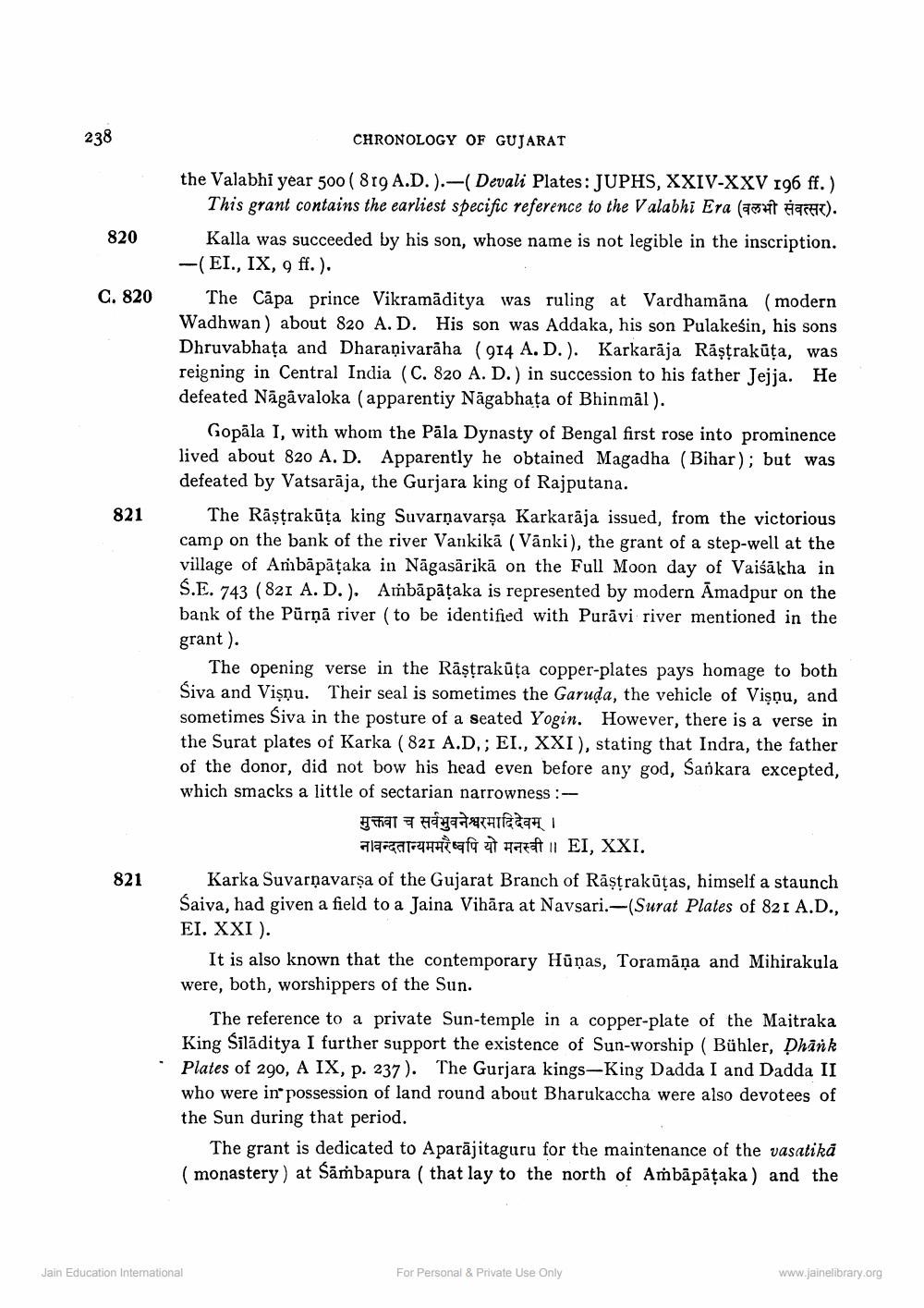________________
238
CHRONOLOGY OF GUJARAT
820
C. 820
821
the Valabhī year 500 ( 819 A.D.).-(Devali Plates: JUPHS, XXIV-XXV 196 ff.)
This grant contains the earliest specific reference to the Valabhi Era (aut HTCT).
Kalla was succeeded by his son, whose name is not legible in the inscription. -(EI., IX, 9 ff.).
The Capa prince Vikramāditya was ruling at Vardhamana (modern Wadhwan) about 820 A. D. His son was Addaka, his son Pulakesin, his sons Dhruvabhata and Dharanivarāha ( 914 A. D.). Karkarāja Rāştrakūta, was reigning in Central India (C. 820 A. D.) in succession to his father Jejja. He defeated Nāgāvaloka (apparentiy Nāgabhata of Bhinmal).
Gopāla I, with whom the Pāla Dynasty of Bengal first rose into prominence lived about 820 A. D. Apparently he obtained Magadha (Bihar); but was defeated by Vatsarāja, the Gurjara king of Rajputana.
The Râştrakūta king Suvarṇavarşa Karkarāja issued, from the victorious camp on the bank of the river Vankikā (Vānki), the grant of a step-well at the village of Ambāpāțaka in Nāgasărikā on the Full Moon day of Vaišākha in S.E. 743 (821 A. D.). Aạbā pāțaka is represented by modern Amadpur on the bank of the Pūrņā river (to be identified with Purāvi river mentioned in the grant).
The opening verse in the Rāştrakūța copper-plates pays homage to both Śiva and Vişnu. Their seal is sometimes the Garuda, the vehicle of Vişņu, and sometimes Siva in the posture of a seated Yogin. However, there is a verse in the Surat plates of Karka ( 821 A.D,; EI., XXI ), stating that Indra, the father of the donor, did not bow his head even before any god, Sankara excepted, which smacks a little of sectarian narrowness :
मुक्तवा च सर्वभुवनेश्वरमादिदेवम् ।
ala-arahisar haft || EI, XXI. Karka Suvarņavarşa of the Gujarat Branch of Rāstrakūtas, himself a staunch Saiva, had given a field to a Jaina Vihāra at Navsari.-(Surat Plates of 821 A.D., EI. XXI ).
It is also known that the contemporary Hūņas, Toramāņa and Mihirakula were, both, worshippers of the Sun.
The reference to a private Sun-temple in a copper-plate of the Majtraka King Silāditya I further support the existence of Sun-worship ( Bühler, Dhank Plates of 290, A IX, p. 237). The Gurjara kings-King Dadda I and Dadda II who were in possession of land round about Bharukaccha were also devotees of the Sun during that period.
The grant is dedicated to A parājitaguru for the maintenance of the vasatikā (monastery) at Sāṁbapura ( that lay to the north of Ambāpāțaka) and the
821
Jain Education Intemational
For Personal & Private Use Only
www.jainelibrary.org




